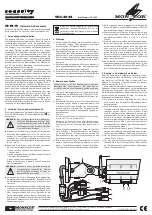
version 1.5 rev 4 Dec 2019
30
Sona &
Marana
4.4.6 b
leMisH
c
oRRection
f
ilteR
The
Blemish Correction Filter
identifies and compensates for three types of blemishes during the FPGA processing
step:
1. Hot Pixels
2. Noisy Pixels
3. Unresponsive Pixels
sCMOS sensors are particularly susceptible to hot pixel blemishes. These are spurious noise pixels that have
significantly higher darkcurrent than the average. Through deep TE cooling of the sensor (e.g. -45
o
C), it is possible to
dramatically minimize the occurrence of such hot pixels within the sensor, and still use them for quantitative imaging.
However, if deep cooling cannot be achieved it is necessary to use interpolative filters to minimize the hot pixel
blemishes. These filters work by taking the mean of the surrounding 8 pixel values and replacing this hot pixel blemish
with this mean value. Such interpolation can be detrimental in some applications that depend on total quantitative
integrity over a limited set of pixels (e.g. PALM and STORM techniques) as well as astronomy. In these applications it
is essential for the user to be able to switch off interpolative corrections. Furthermore, having access to the location of
these blemishes allows an accurate map of ‘good’ pixels to be determined by the user. The end user can request a ‘hot
pixel map’ of their sCMOS sensor from Andor. This map will be generated based on the experimental conditions outlined
by the end user.
4.5 t
RiggeR
M
odes
The Sona/Marana cameras have the following triggering modes:
•
Internal Trigger
- the camera determines the exact time when an exposure happens based on the acquisition
settings entered by the user. This is the most basic trigger mode and requires no external intervention.
•
External Trigger
- the camera and software are in a high state of readiness to accept a trigger from an external
source. Refer to Table X for the minimum pulse width required to guarantee a trigger. The external trigger is fed
via the External Trigger input on the I/O Connector on the camera head.
•
Software Trigger
works in a similar manner to External Trigger mode whereby the camera and software are in
a high state of readiness and can react extremely quickly to a trigger event issued via software. This mode is
particularly useful when the user needs to control other equipment between each exposure and does not know
in advance how long such control will take or if the time taken changes randomly.
•
External Start
is a mode where the camera will wait for one external trigger event to occur after the acquisition
sequence has been started. Once this external trigger event is detected, the camera will start the Internal
Trigger read out process and will progress as if the camera was in internal trigger mode.
•
External Exposure Trigger
is a mode of operation where the exposure time and cycle time are controlled by
the external trigger input.
The TTL inputs and outputs may be used to synchronize the camera operation with external events or equipment.
The individual outputs are described in the following sections.
The AUX_OUT_1 output can be configured via software (Solis or SDK) to provide one of the following outputs: FIRE,
FIRE n, FIRE ALL, or FIRE ANY. The default state provides FIRE ALL on this output.
The polarity of the TTL inputs and outputs can also be inverted (individually) via either Solis or SDK.
NOTE: ‘Row 1’ is the first row read out in the image frame. ‘Row n’ is the last row read out in the image frame.
NOTE: The trigger diagrams in the following sections are for outlining the events and timing of outputs in the
various trigger modes and not to scale.
















































